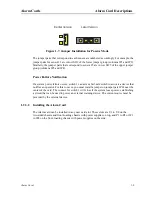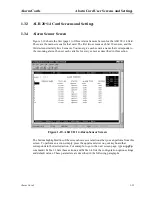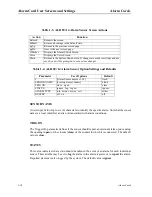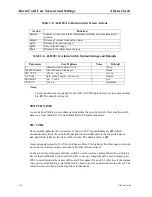
1-22
Alarm Cards
Model No.
Running Head
Alarm Card Error Messages
Alarm Cards
1.4
Alarm Card Error Messages
Refer to Appendix B in the System Reference Guide for further information on Error
Messages regarding this card.
1.5
Alarm Card Troubleshooting
Alarm card problems could indicate a number of possible causes. Typically, a problem is
indicated by the loss of an incoming alarm signal on a sensor port or the lack of a contact
closure/open in response to an internal alarm. Steps designed to isolate the source of the
problem and return the card to normal operation are detailed below. When troubleshooting
Alarm card problems, you should follow this general sequence:
1. Verify that the US/EUR jumper is correctly positioned on the Alarm card to match the
US/EUR jumper on the chassis. Also verify that the voltage level selected is the same on
JP1 and JP2.
2. Verify that the Alarm card sensor filter (SENSOR) is set to either log or report in the
Alarm Filters Menu. This menu is accessed by selecting "Alarms" from the Main Screen
(not the Alarm Card Screen), and then selecting "Filters." Column 1 lists the filter setting
(ignore, log, or report). You can change the filter setting by highlighting the item you
wish to change and pressing the <Enter> key. Use the arrow keys to highlight a new filter
setting and press the <Enter> key again. If you are satisfied with your selections,
remember to "Save" before exiting the screen. If you make any changes and then attempt
to exit the screen without saving, you will be prompted "Ok to lose changes (y/n)?" You
must select "y" or "n". If you select "y", any changes will be lost and all selections will
revert to the last saved state.
3. On the Alarm card menu, verify that the switch/sensor in question is set to active (actv).
If set correctly and the problem is with a switch (contact), go to step 4. If the problem is
with a sensor, go to step 6.
4. Verify that the amphenol cable is connected correctly to the Alarm card. At a
cross-connection point between the Alarm card and the external “scan point”, open the
circuit under test. Connect a Volt-Ohmmeter set to read resistance across the Alarm card
contact in question. If no alarm of the type (Major, Minor or Any) that the contact is
programmed to act upon is present, and it is a normally open (NO) contact, the meter will
read infinite resistance. If you are testing a normally closed (NC) contact, the meter will
read 0 ohms resistance.
5. Generate an alarm of the type (Major, Minor or Any) that the contact is programmed
to act upon. The Volt-Ohmmeter should detect a resistance change from 0 to infinite or
infinite to 0, depending on the type of contact (NO or NC). If no change is detected, the
switch port may be defective.
Содержание ALR 28+14
Страница 1: ...Alarm Cards Reference Guide Publication 999 001967 Revision A1 Release 3 9 October 1999 ...
Страница 4: ...Model No Running Head ...
Страница 6: ...ii Alarm Cards Model No Running Head Contents ...
Страница 8: ...iv Alarm Cards Model No Running Head Figures ...
Страница 10: ...vi Alarm Cards Model No Running Head Tables ...
Страница 34: ...1 24 Alarm Cards Model No Running Head Alarm Card Troubleshooting Alarm Cards ...



































